
6 Installation
Installer reference guide
13
AZQS100~14 AZQS100~140B7Y1B
Split system air conditioners
4P385529-1B – 2016.10
▪ Do NOT apply excessive force to the valve stem. Doing so may
break the valve body.
▪ Always make sure to secure the stop valve with a spanner, then
loosen or tighten the flare nut with a torque wrench. Do NOT place
the spanner on the stem cap, as this could cause a refrigerant
leak.
a
b
a
Spanner
b
Torque wrench
▪ When it is expected that the operating pressure will be low (e.g.
when cooling will be performed while the outside air temperature
is low), sufficiently seal the flare nut in the stop valve on the gas
line with silicon sealant to prevent freezing.
Silicon sealant, make sure there is no gap.
To open/close the stop valve
1
Remove the valve cover.
2
Insert a hexagon wrench (liquid side: 4 mm, gas side: 6 mm)
into the valve stem and turn the valve stem:
Counterclockwise to open.
Clockwise to close.
3
When the valve stem cannot be turned any further, stop turning.
The valve is now opened/closed.
To handle the stem cap
▪ The stem cap is sealed where indicated with the arrow. Do NOT
damage it.
▪ After handling the stop valve, tighten the stem cap, and check for
refrigerant leaks.
Item
Tightening torque (N∙m)
Stem cap, liquid side
13.5~16.5
Stem cap, gas side
22.5~27.5
To handle the service cap
▪ Always use a charge hose equipped with a valve depressor pin,
since the service port is a Schrader type valve.
▪ After handling the service port, tighten the service port cap, and
check for refrigerant leaks.
Item
Tightening torque (N∙m)
Service port cap
11.5~13.9
6.4.8
To connect the refrigerant piping to the
outdoor unit
1
Do the following:
▪ Remove the service cover (a) with screw (b).
▪ Remove the piping intake plate (c) with screw (d).
c
a
b
d
2
Choose a piping route (a, b, c or d).
a
b
c
d
3
If you have chosen the downwards piping route:
▪ Drill (a, 4×) and remove the knockout hole (b).
▪ Cut out the slits (c) with a metal saw.
c
c
b
a
4× Ø6 mm
4
Do the following:
▪ Connect the liquid pipe (a) to the liquid stop valve.
▪ Connect the gas pipe (b) to the gas stop valve.
a
b
5
Do the following:
▪ Insulate the liquid piping (a) and the gas piping (b).
▪ Wind heat insulation around the curves, and then cover it
with vinyl tape (c).
▪ Make sure the field piping does not touch any compressor
components (d).
▪ Seal the insulation ends (sealant etc.) (e).
Summary of Contents for AZQS140B8V1B
Page 27: ......














































